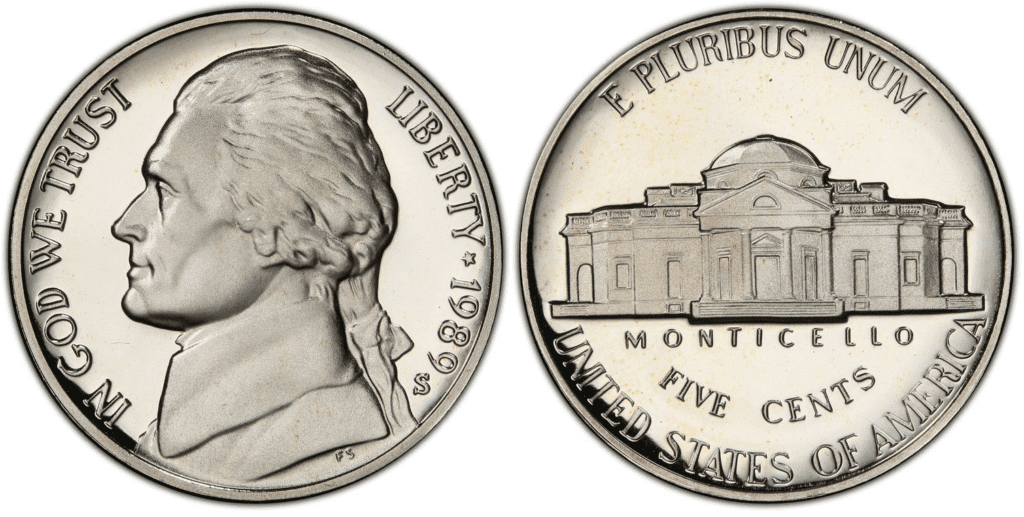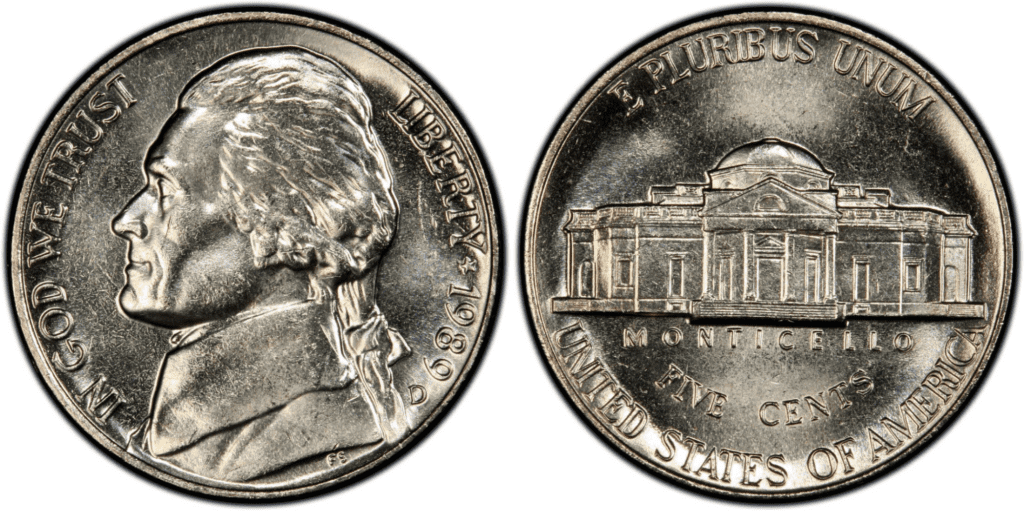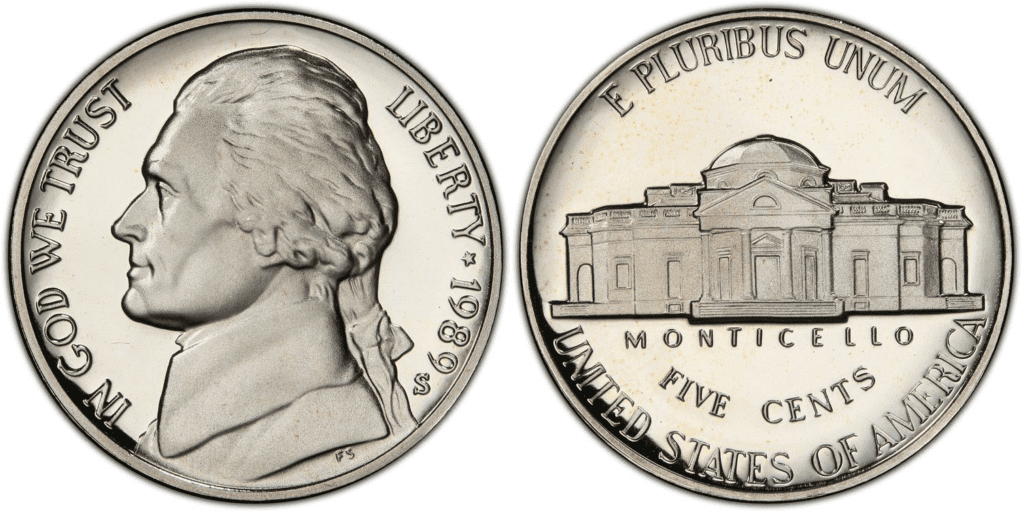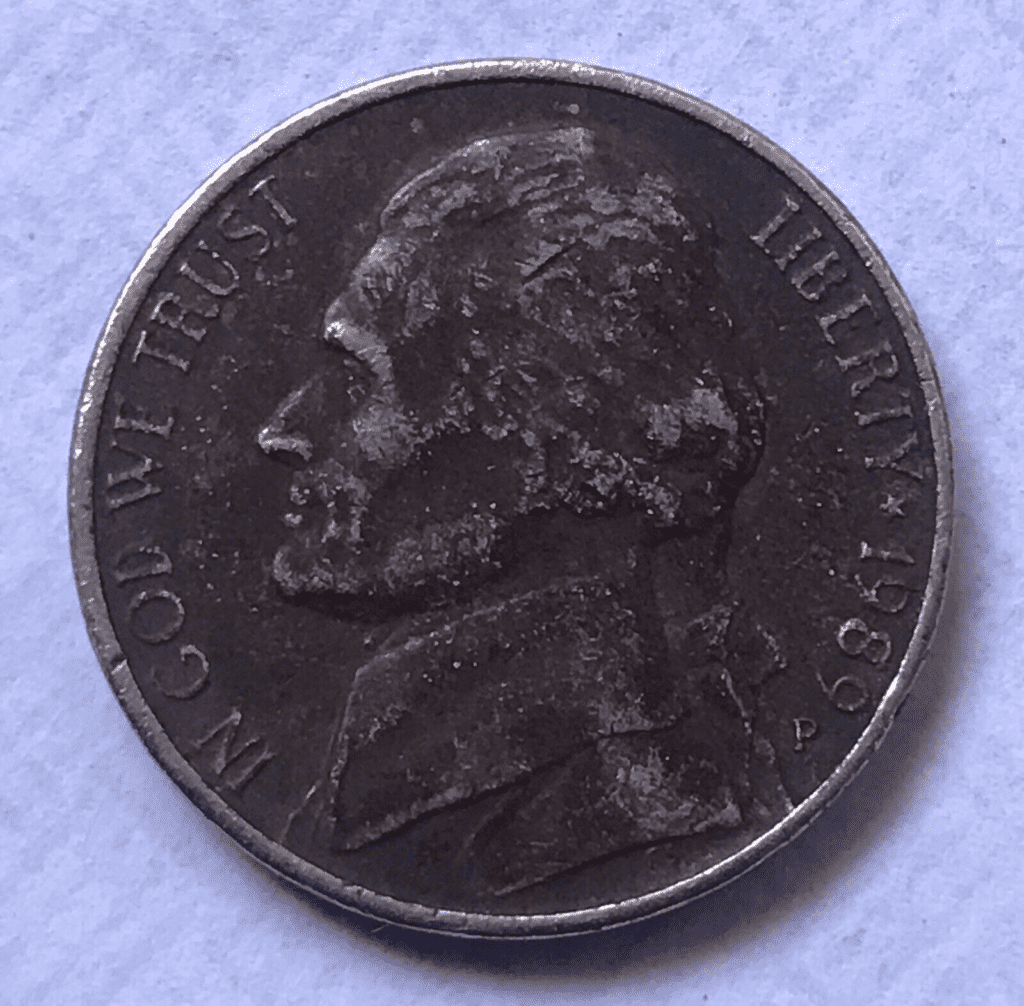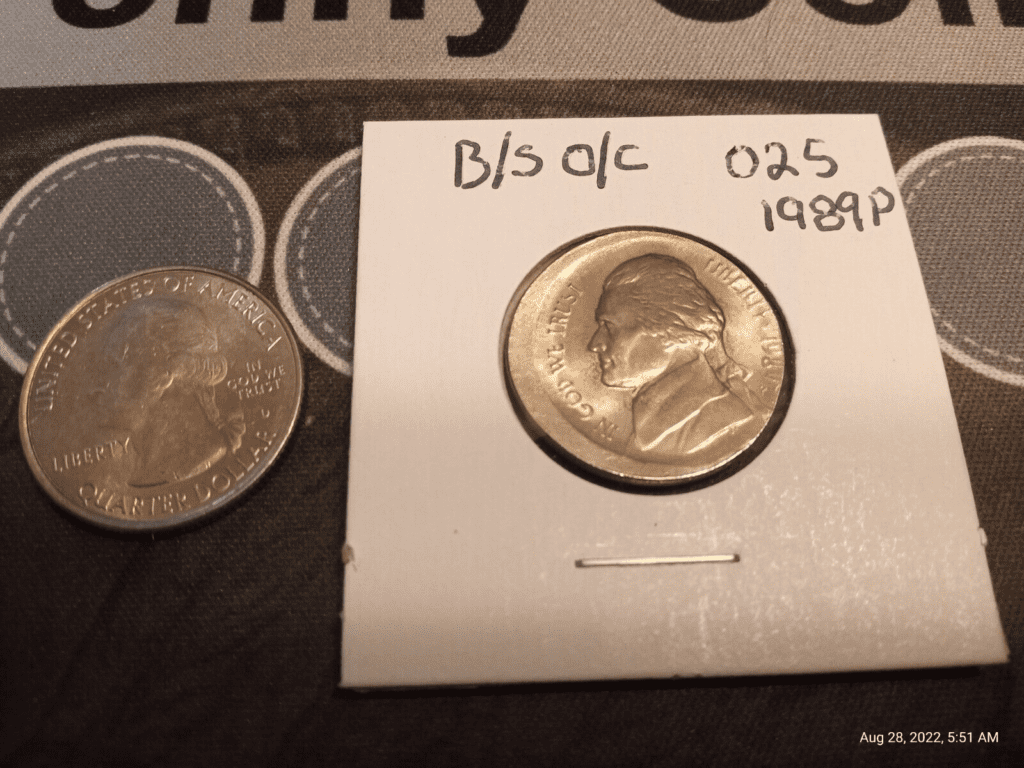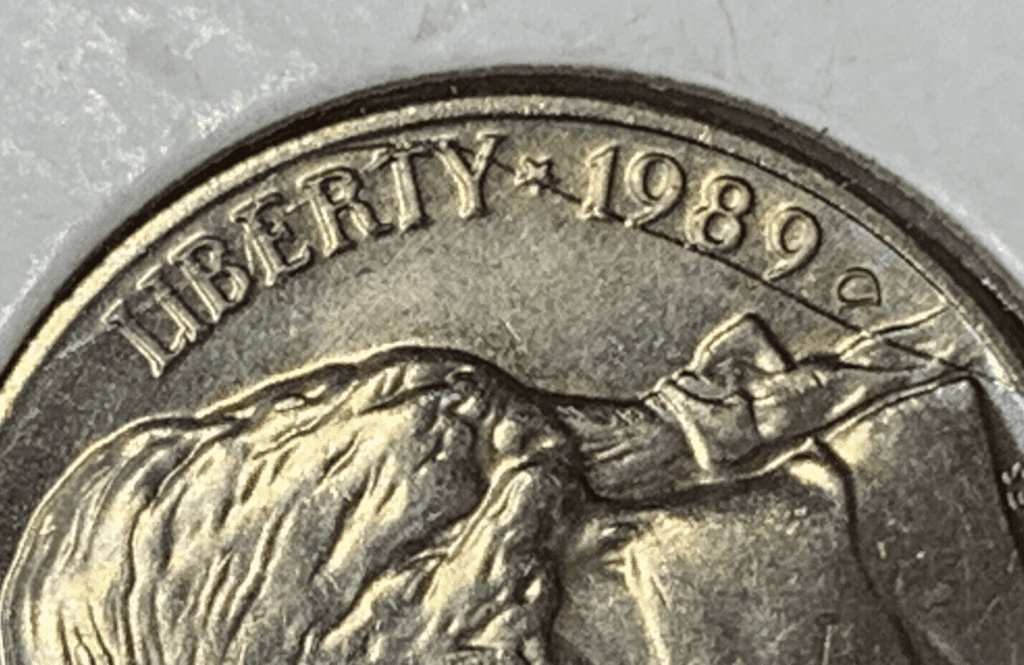What Is the 1989 Jefferson Nickel Made Of?
The 1989 Jefferson nickel is made of 25% nickel and 75% copper. However, from mid-1942 to 1945, war nickels were produced, which are made of 56% copper, 35% silver, and 9% manganese.
This happened because, during World War II, there was a high demand for nickel and copper to build weapons and machinery.
The 1989 Jefferson Nickel has a mass of 5 grams, a diameter of 21.21 mm, and a thickness of 1.95 mm. It has a smooth edge, too.

photo source: USA Coin Book
When it comes to design, the obverse side features the bust of Thomas Jefferson, facing to the left side.
Inscriptions include the following:
- IN GOD WE TRUST
- LIBERTY
- 1989
- Mint mark (if present, can be D, S, and P)
- Designer’s initial (FS – Felix Schlag)
On the reverse side, you’ll find the front view of the Monticello Mansion, which was designed and built by Jefferson Himself.
The inscription includes the following:
- E Pluribus Unum
- UNITED STATES OF AMERICA
- MONTICELLO
- FIVE CENTS
- Designer’s initial (FS)
As its name implies, the Jefferson nickel features the third U.S. President and one of the founding fathers, Thomas Jefferson.
The Jefferson Nickel is worth $0.05. It is also called the half-dime. It was first minted in 1938. Before that, the nickel was designed with a shield, which represents the United States.
From 1866 to 1883, the shield nickel was used until it was replaced by the Liberty Head nickel. Then, in 1913, the Liberty Head nickel was replaced by the Buffalo nickel.
The nickel has continually been produced by the U.S. Mint since 1866 except in 1922, 1932, and 1933.
The buffalo nickel was difficult to coin. The U.S. Mint would like to change it immediately, but they needed to complete the 25-year term. After that, Congress can then replace the design.
The U.S. Mint then held a design competition. One important requirement for the design is that it should have Jefferson’s face on it as well as the Monticello. The artist, Felix Schlag, won the competition. However, he needed to change the reverse design to meet the preference of Congress.
Today, the Jefferson nickel had a slight change in design. The obverse side is now changed. Instead of Jefferson facing to the left, he is now facing forward. The new design was made by Jamie Franki.
1989 Jefferson Nickel Varieties
The 1989 Jefferson Nickel comes in different types. They mainly differ based on their mint marks. Here are the Jefferson nickel varieties you should know:
1989-D Jefferson Nickel
Year of minting: 1989
Mint Mark: D
Place of minting: Denver
Quantity produced: 570,842,474
Face Value: $0.05 (five cents)
Price: $0.05 to $8.00 (or more)
Mass: 5 grams
Edge: Smooth
Designer: Felix Schlag
Composition: 75% copper and 25% nickel
Diameter: 21.21 mm
Thickness: 1.95 mm

photo source: PCGS
The 1989-D Jefferson nickel was made in the Denver Mint. Most of these coins can be sold at around $0.05 to $8.00. After 1989 was over, the Denver Mint produced 570,842,474 Jefferson Nickels.
1989-P Jefferson Nickel
Year of minting: 1989
Mint Mark: P or no mint mark
Place of minting: Philadelphia
Quantity produced: 898,812,000
Face Value: $0.05 (five cents)
Price: $0.28 to $3.06 (or more)
Mass: 5 grams
Edge: Smooth
Designer: Felix Schlag
Composition: 75% copper and 25% nickel
Diameter: 21.21 mm
Thickness: 1.95 mm

photo source: USA Coin Book
The 1989-P Jefferson Nickel can be sold at around $0.28 to $3.06. The Philadelphia Mint produced almost 900 million of these coins.
1989-S Jefferson Nickel
Year of minting: 1989
Mint Mark: S
Place of minting: San Francisco
Quantity produced: 3,220,194
Face Value: $0.05 (five cents)
Price: $0.28 to $4.52 (or more)
Mass: 5 grams
Edge: Smooth
Designer: Felix Schlag
Composition: 75% copper and 25% nickel
Diameter: 21.21 mm
Thickness: 1.95 mm

photo source: PCGS
The San Francisco Mint produced the least number of 1989 Jefferson nickel. It’s not because they are slow but because they produce high-quality nickel coins called proof coins. These coins are polished by hand. Not only that but proof coins are made with better details and a high level of luster.
There are over 3.2 million Jefferson S nickel coins produced in 1989, making it rarer than other nickel types.
List Of 1989 Jefferson Nickel Errors
The 1989 Jefferson Nickel is not exempted when it comes to errors. With billions of nickels produced, it is just a matter of time before an error happens in any part of the minting process.
Here are some of the examples of 1989 Jefferson nickel errors:
1989 P Nickel Missing Clad On Obverse

photo source: eBay
In this error, you’ll see that the 50-cent coin lost its nickel metal covering. That’s why it looks darker than other nickels.
1989 Jefferson Nickel with Planchet flaw on Reverse

photo source: eBay
The planchet wasn’t created perfectly. Thus, when the die was struck on the planchet, you’ll see an imperfect imprint.
1989 Off-Center Jefferson Nickel

photo source: eBay
There was a misalignment between the planchet and the die. Thus, the strike was off-center. The bust of Jefferson is leaning more on the side instead of being at the center.
1989 D Jefferson Nickel with die break

photo source: eBay
Because of the repeated strikes, the die sometimes gets exhausted and eventually breaks. As a result, you’ll see an obvious foreign line that is not part of the design.
How Much Is 1989 Jefferson Nickel Worth Today?
The 1989 Jefferson nickel is worth more or less $0.05. It has a melt value of $0.0551, which is basically almost the same as its face value.
While the usual price of nickel is quite disappointing, you’ll be happy to know that there are 1989 Jefferson nickels that are worth a fortune. In some auction houses, they have seen a single nickel bought by a bidder for more than a thousand dollars.
To give you an idea, here’s a table to help you know the standard pricing of the 1989 Jefferson 50-cent coin.
| Coin | Condition | Grade | Mintage | Value |
| 1989-D Jefferson Nickel | Circulated/Mint | Not graded | 570,842,000 | $0.05-$3.50+ |
| 1989-P Jefferson Nickel | Circulated/Mint | Not graded | 898,812,000 | $0.05-$5.00+ |
| 1989-S Jefferson Nickel | Circulated/Proof | Not graded | 3,220,000 | $0.05-$8.00+ |
| 1989-D Jefferson Nickel | uncirculated/Mint | MS 67 | 570,842,000 | $45-$176 |
| 1989-P Jefferson Nickel | uncirculated/Mint | MS 65 | 898,812,000 | $863-$1,380 |
| 1989-S Jefferson Nickel | Circulated/Proof | MS 69 | 3,220,000 | $7-$20 |
| 1989-S Jefferson Nickel | Circulated/Proof | MS 70 | 3,220,000 | $36-$94 |
How Does The Grading System Work?
The Sheldon Scale is used by numismatists to provide a numerical value to coins. The Sheldon Scale goes from poor (P-1) to perfect mint state (P-1) (MS-70). Coins were originally evaluated using words to reflect their condition (Good, Fair, Excellent, Etc.). Unfortunately, coin collectors and dealers had different ideas about what each of these terms represent.
Professional numismatists joined together in the 1970s and established CoinGrading standards. These numismatists now assign grades at key places on the seventy-point scale, using the most regularly utilized numeric points in conjunction with the original adjective grade. The following are the most common coin grades:
-
-
- (P-1) Poor – Indistinguishable and probably damaged; if used, must have a date and mintmark; otherwise, rather battered.
- (FR-2) Fair – Nearly smooth, but without the damage that a coin graded Poor often possesses. The coin must have enough detail to be identified.
- (G-4) Fair – Inscriptions have merged into the rims in some areas, and important elements have been mostly erased.
- (VG-8) Very Good- A little weathered, but all of the primary design elements are visible, albeit faintly. There is little if any, central detail left.
- (F-12) Good – The item is very worn, yet the wear is even, and the overall design details stand out clearly. Rims are almost completely isolated from the field.
- (VF-20) Very Fine – Moderately weathered, with some finer features still visible. The motto or all letters of LIBERTY are readable. Both sides of the coin have entire rims that are separated from the field.
- (EF-40) Extremely Fine – Gently used; all gadgets are visible, and the most important ones are bold. The finer details are bold and clear, however, light wear may be seen.
- (AU-50) Uncirculated – Slight evidence of wear on the coin’s design’s high points; may have contact marks; eye appeal should be adequate.
- (AU-58) Uncirculated Choice – Slight traces of wear, no severe contact marks, almost full mint shine, and great eye appeal.
- (MS-60) Mint State Basal – Strictly uncirculated; no indication of wear on the coin’s highest points, but an unsightly coin with reduced luster, visible contact marks, hairlines, and other flaws.
- (MS-63) Mint State Acceptable – Uncirculated, but with contact scratches and nicks, little reduced shine, but otherwise appealing appearance. The strike is weak to average.
- (MS-65) Mint State Choice – Uncirculated with great mint shine, very little contact blemishes, and exceptional eye appeal. The strike is unusually severe.
- (MS-68) Mint State Premium Quality – Uncirculated with superb luster, no obvious contact marks to the naked eye, and exceptional eye appeal. The strike is quick and appealing.
- (MS-69) Almost Perfect Mint State – Uncirculated with perfect brilliance, a sharp and appealing strike, and extremely good eye appeal. A near-perfect coin with minor imperfections in the planchet, strike, and contact markings (seen only under 8x magnification).
- (MS-70) Mint State Perfect – Under 8x magnification, there are no tiny imperfections discernible; the strike is crisp, and the coin is perfectly centered on a beautiful planchet. Rarely seen on a coin, this coin is bright and whole, with original luster and exceptional eye appeal.
-
Where To Buy Or Sell 1989 Jefferson Nickel?
The 1989 Jefferson nickel is not rare. With billions of these coins, it should be easy to buy them. If you have Jefferson nickels, you can also sell them at a higher price if they are rare, unique, and still in good condition.
Today, the best place to sell and buy 1989 Jefferson nickels would be on the Internet. With just a few clicks of a button, you can easily find what you’re looking for. Visit online selling platforms such as eBay, Etsy, and Amazon. Also, do a Google search and find websites that specialize in buying and selling coins.
Aside from the Internet, you can buy or sell 1989 fifty-cent coins in coin, antique, and collectors’ shops. You can join auctions as well where you can find some of the rarest and most unique 1989 Jefferson nickels.
FAQs
How much is a 1889 nickel worth?
The 1889 nickel, which is also a Liberty Head Nickel, can be sold at around $10 to $175. That’s for a circulated 1889 nickel coin. Nevertheless, if you have an uncirculated and impressive 1889 nickel, you can sell it for as much as $35,000.
What is the value of a 1989 D Jefferson nickel with “Full Steps”?
On the reverse side of the 1989 D Jefferson nickel, you’ll find the Monticello Mansion. In front of the image is a stair. A high-quality Jefferson nickel will have a detailed five or six steps.
If you let your nickel be examined and it has been rated as a “Full Steps” nickel, then the value of your nickel would dramatically go up.
For example, a 1989 D Jefferson Nickel Full Steps can be sold for $30 to $120 or more, depending on the condition of your coin.
Are 1989-P nickels worth money?
Yes, the 1989-P nickels are worth the money. The question is, by how much? Depending on the condition and features of your 1989-P nickel, the usual price would be around $0.28 to $3.06.

